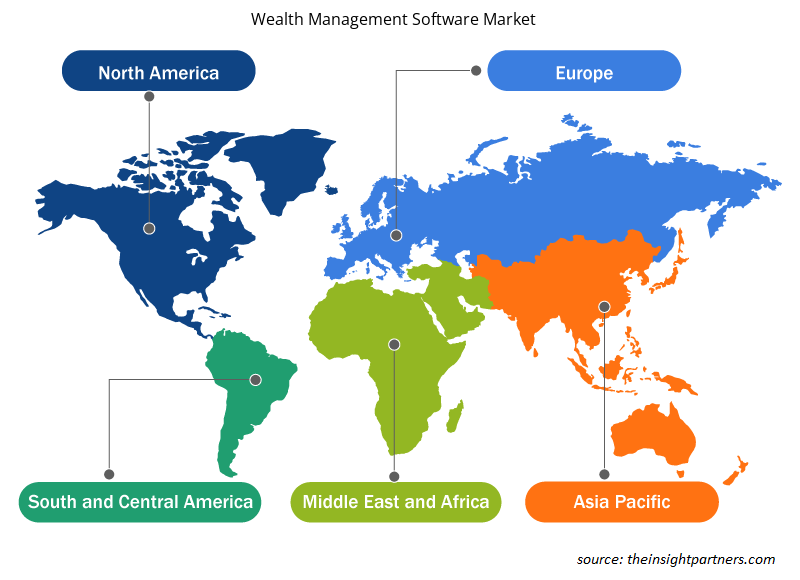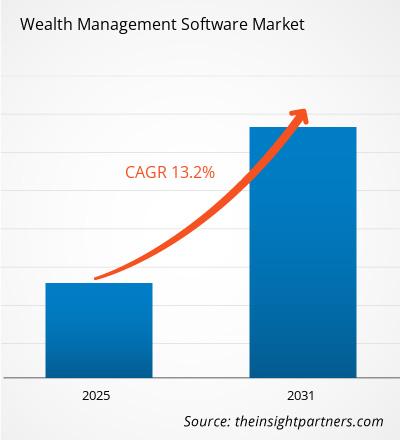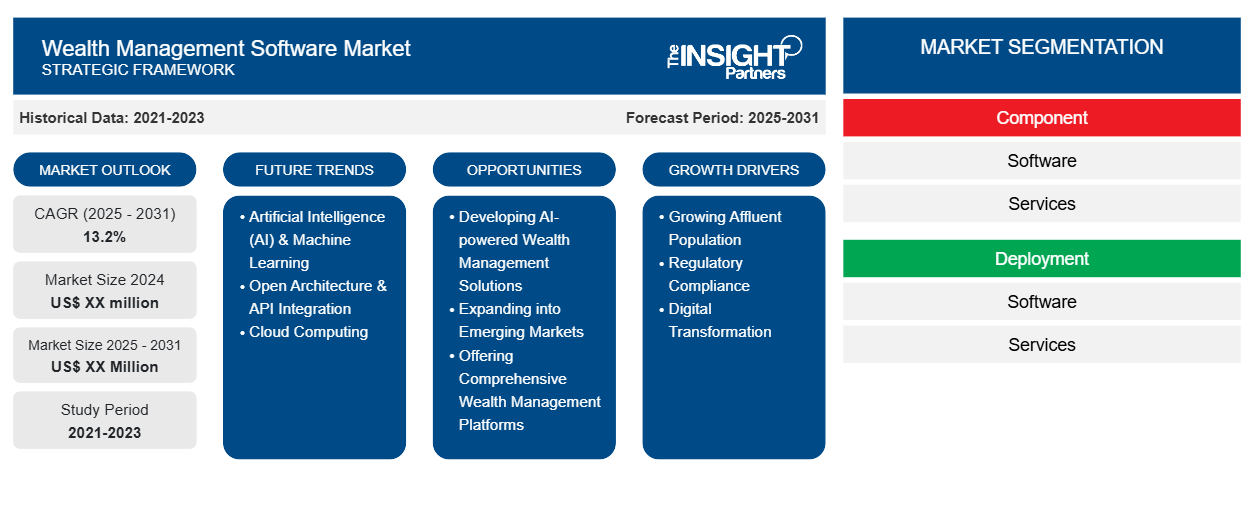Se espera que el mercado de software de gestión patrimonial registre una CAGR del 13,2 % entre 2023 y 2031, con un tamaño de mercado que se expandirá de US$ XX millones en 2023 a US$ XX millones en 2031.
El informe se divide en cuatro secciones: Componente (software, servicios), Implementación (software, servicios), Modo de asesoramiento y Usuario final (bancos, empresas de gestión de inversiones, empresas de comercio y bolsa, empresas de corretaje). El análisis global se desglosa a nivel regional y por países principales. La evaluación del mercado se presenta en dólares estadounidenses para el análisis segmentario anterior.
Propósito del Informe
El informe Wealth Management Software Market de The Insight Partners tiene como objetivo describir el panorama actual y el crecimiento futuro, los principales factores impulsores, los desafíos y las oportunidades. Esto proporcionará información a diversas partes interesadas del negocio, como:
- Proveedores/fabricantes de tecnología: Para comprender la dinámica cambiante del mercado y conocer las oportunidades potenciales de crecimiento, lo que les permitirá tomar decisiones estratégicas informadas.
- Inversionistas: Realizar un análisis exhaustivo de tendencias sobre la tasa de crecimiento del mercado, las proyecciones financieras del mercado y las oportunidades que existen en toda la cadena de valor.
- Órganos reguladores: Regular las políticas y vigilar las actividades del mercado con el objetivo de minimizar los abusos, preservar la confianza de los inversores y defender la integridad y estabilidad del mercado.
Segmentación del mercado de software de gestión patrimonial
Componente
- Software
- Servicios
Despliegue
- Software
- Servicios
Modo de asesoramiento y usuario final
- Bancos
- Empresas de gestión de inversiones
- Empresas de comercio y cambio
- Empresas de corretaje
Geografía
- América del norte
- Europa
- Asia-Pacífico
- América del Sur y Central
- Oriente Medio y África
Geografía
- América del norte
- Europa
- Asia-Pacífico
- América del Sur y Central
- Oriente Medio y África
Personalice este informe según sus necesidades
Obtendrá personalización en cualquier informe, sin cargo, incluidas partes de este informe o análisis a nivel de país, paquete de datos de Excel, así como también grandes ofertas y descuentos para empresas emergentes y universidades.
- Obtenga las principales tendencias clave del mercado de este informe.Esta muestra GRATUITA incluirá análisis de datos, desde tendencias del mercado hasta estimaciones y pronósticos.
Factores impulsores del crecimiento del mercado del software de gestión patrimonial
- Población adinerada en crecimiento: el aumento global de individuos con un alto patrimonio neto (HNWI) y de individuos con un patrimonio neto ultra alto (UHNWI) está impulsando la demanda de software de gestión de patrimonio sofisticado para gestionar carteras complejas y brindar servicios personalizados.
- Cumplimiento normativo: el aumento del escrutinio regulatorio y los requisitos de cumplimiento, como las regulaciones KYC/AML y las leyes de privacidad de datos, requieren soluciones de software de gestión patrimonial sólidas para garantizar el cumplimiento y mitigar los riesgos.
- Transformación digital: la creciente adopción de canales digitales y la creciente demanda de servicios personalizados y convenientes están impulsando la necesidad de soluciones de software de gestión patrimonial digital que puedan satisfacer las necesidades cambiantes de los clientes.
Tendencias futuras del mercado de software de gestión patrimonial
- Inteligencia artificial (IA) y aprendizaje automático: la IA y el aprendizaje automático se están integrando cada vez más en el software de gestión patrimonial para permitir asesoramiento de inversión personalizado, optimización de carteras y gestión de riesgos.
- Arquitectura abierta e integración de API: las API abiertas y la interoperabilidad son cada vez más importantes, lo que permite una integración perfecta con aplicaciones y fuentes de datos de terceros para brindar una experiencia al cliente más completa y personalizada.
- Computación en la nube: la migración del software de gestión de patrimonio a la nube está ganando terreno y ofrece mayor escalabilidad, flexibilidad y rentabilidad.
Oportunidades de mercado en el software de gestión patrimonial
- Desarrollo de soluciones de gestión patrimonial impulsadas por IA: centrarse en el desarrollo de soluciones impulsadas por IA, como asesores robotizados y herramientas de gestión de cartera impulsadas por IA, para mejorar la toma de decisiones de inversión y mejorar los resultados de los clientes.
- Expansión a mercados emergentes: Explore mercados sin explotar en economías en desarrollo donde la industria de gestión de patrimonio está creciendo rápidamente.
- Ofreciendo plataformas integrales de gestión patrimonial: Ofrecemos plataformas integrales de gestión patrimonial que abarcan todos los aspectos de la gestión patrimonial, incluida la gestión de inversiones, la planificación financiera y la planificación patrimonial.
Perspectivas regionales del mercado de software de gestión patrimonial
Los analistas de Insight Partners explicaron en detalle las tendencias y los factores regionales que influyen en el mercado de software de gestión patrimonial durante el período de pronóstico. Esta sección también analiza los segmentos y la geografía del mercado de software de gestión patrimonial en América del Norte, Europa, Asia Pacífico, Oriente Medio y África, y América del Sur y Central.

- Obtenga datos regionales específicos para el mercado de software de gestión patrimonial
Alcance del informe de mercado de software de gestión patrimonial
| Atributo del informe | Detalles |
|---|---|
| Tamaño del mercado en 2023 | XX millones de dólares estadounidenses |
| Tamaño del mercado en 2031 | US$ XX millones |
| Tasa de crecimiento anual compuesta (CAGR) global (2023-2031) | 13,2% |
| Datos históricos | 2021-2022 |
| Período de pronóstico | 2024-2031 |
| Segmentos cubiertos | Por componente
|
| Regiones y países cubiertos | América del norte
|
| Líderes del mercado y perfiles de empresas clave |
|
Densidad de actores del mercado de software de gestión patrimonial: comprensión de su impacto en la dinámica empresarial
El mercado de software de gestión patrimonial está creciendo rápidamente, impulsado por la creciente demanda de los usuarios finales debido a factores como la evolución de las preferencias de los consumidores, los avances tecnológicos y una mayor conciencia de los beneficios del producto. A medida que aumenta la demanda, las empresas amplían sus ofertas, innovan para satisfacer las necesidades de los consumidores y aprovechan las tendencias emergentes, lo que impulsa aún más el crecimiento del mercado.
La densidad de actores del mercado se refiere a la distribución de las empresas o firmas que operan dentro de un mercado o industria en particular. Indica cuántos competidores (actores del mercado) están presentes en un espacio de mercado determinado en relación con su tamaño o valor total de mercado.
Las principales empresas que operan en el mercado de software de gestión patrimonial son:
- Comarca SA
- Sociedad Limitada.
- Servicios de Información Nacional de Fidelity, Inc.;
- Compañía: Fiserv, Inc.
- Objectway SpA
- Software de perfil
Descargo de responsabilidad : Las empresas enumeradas anteriormente no están clasificadas en ningún orden particular.

- Obtenga una descripción general de los principales actores clave del mercado de software de gestión patrimonial
Puntos de venta clave
- Cobertura integral: el informe cubre exhaustivamente el análisis de productos, servicios, tipos y usuarios finales del mercado de software de gestión patrimonial, proporcionando un panorama holístico.
- Análisis de expertos: el informe se compila sobre la base de un profundo conocimiento de expertos y analistas de la industria.
- Información actualizada: El informe asegura relevancia comercial debido a su cobertura de información reciente y tendencias de datos.
- Opciones de personalización: este informe se puede personalizar para satisfacer los requisitos específicos del cliente y adaptarse adecuadamente a las estrategias comerciales.
Por lo tanto, el informe de investigación sobre el mercado de software de gestión patrimonial puede ayudar a abrir camino para descifrar y comprender el escenario de la industria y las perspectivas de crecimiento. Si bien puede haber algunas preocupaciones válidas, los beneficios generales de este informe tienden a superar las desventajas.
- Análisis histórico (2 años), año base, pronóstico (7 años) con CAGR
- Análisis PEST y FODA
- Tamaño del mercado, valor/volumen: global, regional y nacional
- Industria y panorama competitivo
- Conjunto de datos de Excel
Informes recientes
Informes relacionados
Testimonios
Razón para comprar
- Toma de decisiones informada
- Comprensión de la dinámica del mercado
- Análisis competitivo
- Información sobre clientes
- Pronósticos del mercado
- Mitigación de riesgos
- Planificación estratégica
- Justificación de la inversión
- Identificación de mercados emergentes
- Mejora de las estrategias de marketing
- Impulso de la eficiencia operativa
- Alineación con las tendencias regulatorias





















 Obtenga una muestra gratuita para - Mercado de software de gestión patrimonial
Obtenga una muestra gratuita para - Mercado de software de gestión patrimonial